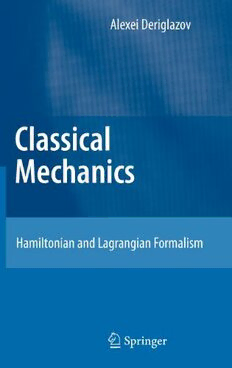Table Of ContentClassical Mechanics
Alexei Deriglazov
Classical Mechanics
Hamiltonian and Lagrangian Formalism
123
AlexeiDeriglazov
Depto.deMatemática
UniversidadeFederaldeJuizdeFora
36036-330JuizdeFora
MG,Brazil
[email protected]
ISBN978-3-642-14036-5 e-ISBN978-3-642-14037-2
DOI10.1007/978-3-642-14037-2
SpringerHeidelbergDordrechtLondonNewYork
LibraryofCongressControlNumber:2010932503
(cid:2)c Springer-VerlagBerlinHeidelberg2010
Thisworkissubjecttocopyright.Allrightsarereserved,whetherthewholeorpartofthematerialis
concerned,specificallytherightsoftranslation,reprinting,reuseofillustrations,recitation,broadcasting,
reproductiononmicrofilmorinanyotherway,andstorageindatabanks.Duplicationofthispublication
orpartsthereofispermittedonlyundertheprovisionsoftheGermanCopyrightLawofSeptember9,
1965,initscurrentversion,andpermissionforusemustalwaysbeobtainedfromSpringer.Violations
areliabletoprosecutionundertheGermanCopyrightLaw.
Theuseofgeneraldescriptivenames,registerednames,trademarks,etc.inthispublicationdoesnot
imply,evenintheabsenceofaspecificstatement,thatsuchnamesareexemptfromtherelevantprotective
lawsandregulationsandthereforefreeforgeneraluse.
Coverdesign:eStudioCalamarS.L.,Heidelberg
Printedonacid-freepaper
SpringerispartofSpringerScience+BusinessMedia(www.springer.com)
Preface
Formalism of classical mechanics underlies a number of powerful mathematical
methods,widelyusedintheoreticalandmathematicalphysics[1–11].Intheselec-
tureswepresentsomeselectedtopicsofclassicalmechanics,whichmaybeuseful
forgraduatelevelstudentsintendingtoworkinoneofthebranchesofavastfieldof
theoretical physics. Except for the last chapter, which is devoted to the discussion
ofsingulartheoriesandtheirlocalsymmetries,thetopicsselectedcorrespondtothe
standardcourseofclassicalmechanics.
Fortheconvenienceofthereader,wehavetriedtomakethematerialofdifferent
chaptersasindependentaspossible.So,thereaderwhoisfamiliarwithLagrangian
mechanicscanproceedtoanyoneofChaps.3,4,5,6,7,8afterreadingthesecond
chapter.
Inourpresentationofthematerialwehavetried,wherepossible,toreplaceintu-
itivemotivationsand“scientificfolklore”byexactproofsordirectcomputations.To
illustratehowclassical-mechanicsformalismworksinotherbranchesoftheoretical
physics,wehavepresentedexamplesrelatedtoelectrodynamics,aswellastorela-
tivisticandquantummechanics.Mostofthesuggestedexercisesaredirectlyrelated
tothemainbodyofthetext.
While in some cases the formalism is developed beyond the traditional level
adoptedinthestandardtextbooksonclassicalmechanics[12–14],theonlymathe-
maticalprerequisitesaresomeknowledgeofcalculusandlinearalgebra.
In the frameworks of classical and quantum theories, the Hamiltonian and
Lagrangianformulationseachhaveadvantagesanddisadvantages.Sinceourfocus
hereisHamiltonianmechanics,letusmentionsomeoftheargumentsforusingthis
typeofformalism.
• There is a remarkable democracy between variables of position and velocity in
Nature:beingindependentonefromanother,theycontaincompleteinformation
on the properties of a classical system at a given instance. Besides, just the
positionsandvelocitiesattheinitialinstantoftimearenecessaryandsufficient
to predict an evolution of the system. In Lagrangian formalism this democracy,
while reflected in the initial conditions, is not manifest in the course of evo-
lution,sinceonlyvariablesofpositionaretreatedasindependentinLagrangian
equations.Hamiltonianformalismrestoresthisdemocracy,treatingpositionsand
v
vi Preface
velocitiesonequalfooting,asindependentcoordinatesthatparameterizeaphase
space.
• Accordingtothecanonicalquantizationparadigm,theconstructionoftheHamil-
tonian formulation for a given classical system is the first necessary step in the
passagefromclassicaltoquantumtheory.Itissufficienttopointoutthatquantum
evolution intheHeisenberg pictureisobtained fromtheHamiltonian equations
throughreplacementofthephase-spacevariablesbycorrespondingoperators.As
totheoperators,theircommutatorsarerequiredtoresemblethePoissonbrackets
ofthephase-spacevariables.
• Theconventionalwaytodescribearelativistictheoryistoformulateitinterms
ofasingularLagrangian(thesingularityisthepricewepayforthemanifestrela-
tivisticinvarianceoftheformulation).Itimpliesarathercomplicatedstructureof
Lagrangianequations,whichmayconsistofbothsecondandfirst-orderdifferen-
tialequationsaswellasalgebraicones.Besides,theremaybeidentitiespresent
amongtheequations,whichimpliesfunctionalarbitrarinessinthecorresponding
solutions. It should be mentioned that, in the modern formulation, physically
interesting theories (electrodynamics, gauge field theories, the standard model,
stringtheory,etc.)areofthistype.Inthiscase,Hamiltonianformulationgivesa
somewhat clearer geometric picture of classical dynamics [8]: all the solutions
are restricted to lying on some surface in the phase space, while the above-
mentioned arbitrarinessisavoidedbypostulatingclassesofequivalent trajecto-
ries.Physicalquantitiesarethenrepresentedbyfunctionsdefinedintheseclasses.
The procedure for investigation of this picture is based entirely on the use of
specialcoordinatesadoptedtothesurface,whichinturnrequirearatherdetailed
developmentofthetheoryofcanonicaltransformations.AltogetherHamiltonian
formulationleadstoaself-consistentphysicalinterpretationofageneralsingular
theory, forming the basis for numerous particular prescriptions and approaches
toquantizationofconcretetheories[10].
JuizdeFora,July2010
AlexeiDeriglazov
Notation andconventions
Theterminologyofclassicalmechanicsisnotuniversal.Toavoidanyconfusion,the
quantities of the configuration (phase) space are conventionally called Lagrangian
(Hamiltonian)quantities.
Generalized coordinates of the configuration space are denoted by qa. Latin
indicesfromthebeginningofthealphabeta,b,c,andsoongenerallyrangefrom1
ton,a =1,2,...,n.
Phase space coordinates are often denoted by one letter zi = (qa,p ). Latin
b
indicesfromthemiddleofthealphabeti, j,k,andsoongenerallyrangefrom1to
2n,i =1,2,...,2n.
Greekindicesfromthebeginningofthealphabetα,β,γ areusedtodenotesome
subgroupofthegroupofvariables,forexampleqa =(q1,qα),α =2,3,...,n.
Preface vii
Repeated indices are generally summed, unless otherwise indicated. The “up”
and “down” position of the index of any quantity is fixed. For example, we write
qa,p andneveranyotherway.
b
Timevariableisdenotedeitherbyτ orbyt.Adotoveranyquantitydenotesthe
time-derivativeofthatquantity
dqa
q˙a = ,
dτ
whilepartialderivativesaredenotedby
∂L(q) ∂H(z)
=∂ L, =∂ H,
∂qa a ∂zi i
Thesamesymbolisgenerallyusedtodenoteavariableandafunction.Forexample,
we write z(cid:3)i = z(cid:3)i(zj), instead of the expression z(cid:3)i = fi(zj) for the change of
coordinates.
Thenotation
F(q,v)|v(z) ≡ F(q,v)|v=v(z) ≡ F(q,v)|,
impliesthesubstitutionofthefunctionva(z)inplaceofthevariableva.
Contents
1 SketchofLagrangianFormalism ................................. 1
1.1 Newton’sEquation.......................................... 1
1.2 GalileanTransformations:PrincipleofGalileanRelativity......... 8
1.3 PoincaréandLorentzTransformations:ThePrincipleofSpecial
Relativity................................................. 13
1.4 PrincipleofLeastAction..................................... 23
1.5 VariationalAnalysis......................................... 24
1.6 Generalized Coordinates, Coordinate Transformations
andSymmetriesofanAction ................................ 29
1.7 ExamplesofContinuous(Field)Systems ....................... 36
1.8 ActionofaConstrainedSystem:TheRecipe .................... 44
1.9 ActionofaConstrainedSystem:JustificationoftheRecipe........ 51
1.10 DescriptionofConstrainedSystembySingularAction............ 52
1.11 KineticVersusPotentialEnergy:ForcelessMechanicsofHertz..... 54
1.12 ElectromagneticFieldinLagrangianFormalism ................. 56
1.12.1 MaxwellEquations .................................. 56
1.12.2 NonsingularLagrangianActionofElectrodynamics....... 59
1.12.3 Manifestly Poincaré-Invariant Formulation in Terms
ofaSingularLagrangianAction ...................... 63
1.12.4 NotionofLocal(Gauge)Symmetry .................... 65
1.12.5 LorentzTransformationsofThree-DimensionalPotential:
RoleofGaugeSymmetry ............................ 68
1.12.6 RelativisticParticleonElectromagneticBackground ...... 69
1.12.7 PoincaréTransformationsofElectricandMagneticFields . 72
2 HamiltonianFormalism ......................................... 77
2.1 DerivationofHamiltonianEquations........................... 77
2.1.1 Preliminaries ....................................... 77
2.1.2 FromLagrangiantoHamiltonianEquations ............. 79
2.1.3 Short Prescription for Hamiltonization Procedure,
PhysicalInterpretationofHamiltonian ................. 83
ix

